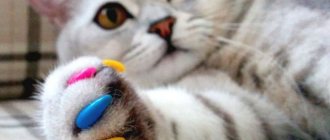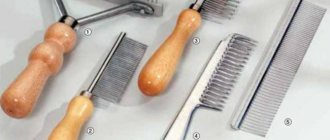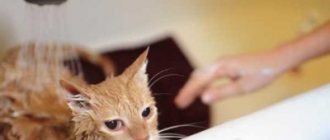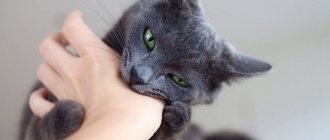4022Administration
Cats in the wild are hunters. All cats sharpen their claws. The item they strip in the apartment could be an expensive leather sofa or freshly hung wallpaper. In any case, upholstery and wallpaper torn to shreds cannot please pet owners. How to stop a cat from tearing up wallpaper is a question no less important than teaching a cat not to shit in the corners. The owner of the animal, first of all, must know what cat claws are, and why the cat needs to sharpen them and tear wallpaper.
Reasons for damage to furniture and walls
Instilling decent behavior occurs when the kitten is about 3 months old. Often the animal is raised by the owner or the kitten's mother. But if you take a cat who lived in a shelter or on the street, then the pet’s behavior may not please you. The advantage is that it is possible to discourage a cat from tearing up wallpaper and pieces of furniture at any age. However, it is worth considering that the older the cat is, the stronger his habits are, therefore, it will take much more time to unlearn.
Most inexperienced owners punish the animal by beating it in the hope of developing a conditioned reflex. Using such methods, the main factors are not taken into account:
- The cat needs to sharpen its claws. When he claws into the sofa, he removes the dead layer of the claw.
- All cats mark their territory with scent. There are glands in the middle of the animal's fingers that secrete a smelling secretion. The pet, by scratching corners, door frames, wallpaper, marks the area of its home.
The next factor why cats scratch wallpaper and the sofa is stress, which manifests itself in the form of:
- jealousy of other pets, new faces in the apartment. The animal will begin to scratch furniture and walls with the smell of a stranger in its area;
- territoriality - torn curtains, wallpaper near windows and doors indicate that the pet is worried. Maybe the cat is watching the cat from the window, or smells a smell near the door. By leaving scratches on the surface, the pet marks its own area;
- disagreements with other animals that live in the same room - in such a situation, feeding areas and shared places where pets do not get along will suffer;
- other stresses - change of breeder, place of residence, loss or illness of a family member, long separation from the owner, lack of attention.
An important factor is untimely, improper training of the cat. The training procedure may be influenced by the age of the animal. Kittens and young cats may not know that scratching interior items is not allowed.
When a cat likes to peel off soft, textured wallpaper, and has done this repeatedly, it will take much longer to retrain the pet.
After observing the cat, you can easily determine the cause of scratching. If inappropriate behavior is associated with a lack of attention and lack of self-confidence, then you need to re-educate your pet. Initially, it is necessary to provide convenience and create conditions to care for the claws.
How to decorate walls: advice from experienced cat owners
If your beloved pet has rendered the wallpaper in your apartment completely unusable, it’s time to start making repairs.
Try covering your walls with vinyl or fiberglass wallpaper. There is no full guarantee that the cat will not encroach on them, but they are very easy to wash with a sponge and laundry soap, do not lose their appearance for a long time and are easily repainted.
Another option: finishing with decorative plaster, just choose more durable brands.
Panels made of plastic or chipboard would be a good option. A cat's claws cannot cause them much harm. And if any of the slabs are damaged, it is not difficult to replace it with a new one.
Wall cladding with porcelain stoneware or artificial stone is considered the most reliable. It is not necessary to decorate the walls from floor to ceiling with these materials. Half this height is enough. The main thing is that the cat’s paws will not leave a trace on them.
Using a scratching post
The most popular way to eliminate the problem is a scratching post - a device for grinding down claws. You can buy it at the store, or make it yourself. Often, felt, rope, or carpet are used for this.
Scratching posts can come in different models, shapes, and sizes. They are equipped with cat houses, presented in the form of individual poles, planks, or entire complexes for games. They are also made from different materials - wood, jute, cardboard. It’s better to take a scratching post that is similar to the material your pet loves.
But it’s not enough to just install an object for grinding claws in the house; you also need to get the animal interested in it. Anyone who has experience with cats knows how capricious they are. It is also known about the curiosity of cats, which is important to emphasize when teaching not to peel off the wallpaper and the sofa.
- The scratching post is placed in the places where the cat likes to be most. If you have several favorite areas, you can buy a couple of models and install them around the house. The structure must be well secured so that the cat can lean on it while grinding its claws.
- It is important to regularly attract the kitten’s attention to a new toy by running its paws along the rough surface.
- If the animal does not understand that a new object in the house is intended for grinding off its claws, do not scream or hit the pet. You need to train him, because cats are smart animals. When the cat starts to scratch the wallpaper, you can use a spray bottle of water to repel it, and then take it to the scratching post. Showed interest in a new accessory can be encouraged with a treat.
Many cats, when meeting their owner, stretch and extend their claws. If you place a scratching post near the front door, this will keep the wallpaper intact and encourage the animal.
How does a cat's claw work?
A cat's paw is designed in such a way that each claw has its own case, into which it is retracted when the cat walks or runs. The work of ligaments and tendons ensures that they are pulled into the pads and instantly released if necessary.
© shutterstock
The claw also has a complex structure. It consists of two parts: internal and external. Internal is soft bone tissue penetrated by vessels and nerves. The outer shell is a special type of protein (keratin) that protects the inside of the claw from damage.
Cat claws grow throughout their lives. The keratinized layer must be removed, otherwise the claws will become too long and will not fit into their cases. They will become dull when they come into contact with the soil. With such claws, a cat will not be able to climb a tree, hold onto prey, or protect itself from attack. Thanks to constant cleaning, a cat's paw with sharp claws is a formidable weapon capable of causing deep wounds. A cat always sharpens the claws on its front paws. They are the striking force of the predator.
Overlays
To discourage your pet from scratching wallpaper and furniture, you will need special anti-scratch pads. This accessory is presented in the form of soft caps, which allows you to quickly eliminate the problem of scratching.
However, this method is quite troublesome and expensive. The pads will need to be changed every 2-3 weeks. After removing them, the cat's claws need to be filed. Only then is it allowed to glue new anti-scratch pads. It is better to carry out the procedure in a pet salon.
Thanks to the overlays, you can protect furniture and wallpaper, but their use is possible as a temporary measure. This is explained by the fact that the caps prevent the cat from staying on the surface, so falls from a height are not excluded.
The means used to attach the caps can lead to an allergic reaction or abscess if the pet injures a finger while wearing it. The cat may feel pain because the anti-scratch guards do not allow the claws to retract. The possibility of scratching is also excluded. When trying to rip off the caps, the pet may injure its fingers or pull out its claws. Before you put anti-scratch pads on your pet, think carefully. For cats that go outside, this method of preserving furniture and wallpaper is not suitable.
Education and training
A cat should not be physically punished for damaging things. Sharpening her claws is a natural behavior for her. The animal will not understand what it has done wrong and will see the owner as an enemy.
Cats are able to grasp cause-and-effect relationships, so to correct their behavior they develop conditioned reflexes:
- After each approach to the scratching post, the pet is encouraged: praised, petted, treated with delicious food.
- Cats cannot tolerate harsh sounds. When trying to scratch furniture, they suddenly clap their hands or knock with metal objects.
- A tin can with coins inside is placed nearby: if the cat touches it, it falls with a roar and scares away the animal.
- At the moment of committing an offense, the pet is sprayed with a stream of water from a spray bottle.
- At the same time, they are taught the prohibitory words “No”, “Ugh”, “No”. Commands are pronounced loudly, with confident intonation.
After these steps, the cat is taken to the scratching post and carefully scraped with its paws along the surface. Educational measures produce results if they are repeated systematically.
Stroking the fur
Weaning an animal away from what is its natural behavior is not an easy task. Only prohibitions will not help here. To make it clear to the cat that the owner loves him, and you can sharpen his claws not only on wallpaper, you must not forget to praise your purr. If he picks at the scratching post, pet your pet. This way he will understand much faster which behavior is preferable. Scolding a cat is useless. He may harbor a grudge and further damage things and decor in the apartment in order to take revenge on the owner. If you love your cat, you will definitely find out how to gently stop him from sharpening his claws on interior elements.
How to make a scratching post yourself and distract your cat from the wallpaper?
Material: Wood, fabric, twine, sisal, artificial materials, plastic pipes, natural twine wrapping, carpet (cardboard, fiberboard, corrugated cardboard, thin fabrics cannot be used).
Which one should I do?
- Designs: With toys, with a hammock, with shelves, levels, transition bridges, in the form of a tower.
- Shape: Ring, wave, horizontal on the floor, vertical, on both sides of the corner.
- Dimensions: Dimensions from 50 cm to a meter.
The easiest way is a post wrapped in rope, preferably natural twine. Step-by-step instruction:
- Choose a stable base.
- For a pole, it is better to use a plastic pipe or a wooden beam.
- The base must be connected to the post with screws.
- Wrap the rope very tightly so that each turn fits tightly to the nearest ones. Every 5 cm, lubricate the pipe with glue for strength.
- A sun lounger can be attached to the top of the structure.
Smell repellent method
Most cats develop persistent habits, that is, they prefer to tear wallpaper in certain places.
To avoid this, you can sew fabric bags and soak them in essential citrus oil (felines do not like the smell of citrus), scattering them in these places.
But in this case, it is also important to get a scratching post, because the cat may simply start scratching another wall.
Anti-scratch: closing the claws
Nowadays there are special silicone overlays (caps) for claws on sale. They are glued to the pet over its claws and prevent them from tearing wallpaper and other objects. They fall off on their own, along with the stratum corneum, in about 6-8 weeks. After that you need to stick the following ones. When you first stick them on, cats try to chew them off, but after a day or two they get used to them and don’t pay any attention to them at all.
The use of caps solves two problems - it helps to fall off dead nail formations and wean the cat so that he does not tear up the walls. But not all animals can easily tolerate the procedure of gluing their claws, just as not all owners want to do this. Therefore, we will consider other methods.
How to start house training a cat
The process will not take much time and effort if you are just going to adopt a pet. In this case, the house must be purchased in advance, and the baby will immediately know its place. Even if the kitten is already in the house, thanks to its curiosity, it will quickly get used to the house.
An adult animal with established habits is a different matter. It is possible that the cat will immediately fall in love with its new home. But there are some tricks to win over conservatives too.
Using your favorite places
If your pet has lived with you for a long time, there are corners in the apartment where he spends time and sleeps more often. Place the house in such a place, and the cat will enter it, following its habit. Your pet's conservatism will play into your hands - the fluffy will sleep where he loves, and at the same time get used to the housing. If your cat sleeps on the bed with you, you can briefly tolerate the proximity of the apartment next to the bed, or even on it, if space allows.
After three weeks, try to move the house. If the pet does not follow, you need to return the corner back for some more time. Eventually the animal will fall in love with the structure itself, and the cat will willingly follow it.
Using Natural Curiosity
Bring the purchased house into the apartment and place it where it will be immediately visible to your pet. If the cat does not go there right away, take a few days to get used to the new piece of furniture. Then, during the game, you can throw your favorite ball or mouse inside - the first step is taken, the animal goes inside to get the toy. Gradually move your favorite toys inside the structure. The best option is if the cat believes that this is her choice, do not forget that mustachioed friends are very capricious.
Use your fluffy's favorite treat as bait, and visits to your home will become more frequent. Use one of your old things that the cat likes to lie on as bedding - the room will become close in smell. Gradually, your baby will get used to it and begin to sleep in the structure, first during the day, then at night.
Using gentle pressure
Take your pet in your arms and take it to the house, stroking and talking to it as you do so. If the pet settles down calmly in its new home, stroke it while holding it lightly. To reinforce the conditioned reflex, treat him to something tasty. Move the cat during sleep so that he wakes up in a new place, this will speed up recognition.
Reward
Praise your baby when he spends time in his house, treat him with goodies. Cats are smart animals; the owner’s approval, love and affection are important to them. This is the best way to reinforce your pet's correct behavior.
Using Tricks
If your pet is stubborn, resort to other tactics. All cats are partial to catnip. Pet stores sell the weed itself, sprays with the scent of mint, and toys stuffed with it. Regularly, until the pet gets used to the house, scatter or spray catnip, the cat will not be able to resist, will certainly enter the house and stay there for a while. Valerian root also attracts fluffies; it can be used, but not for too long - in cats it causes an effect similar to human intoxication.











